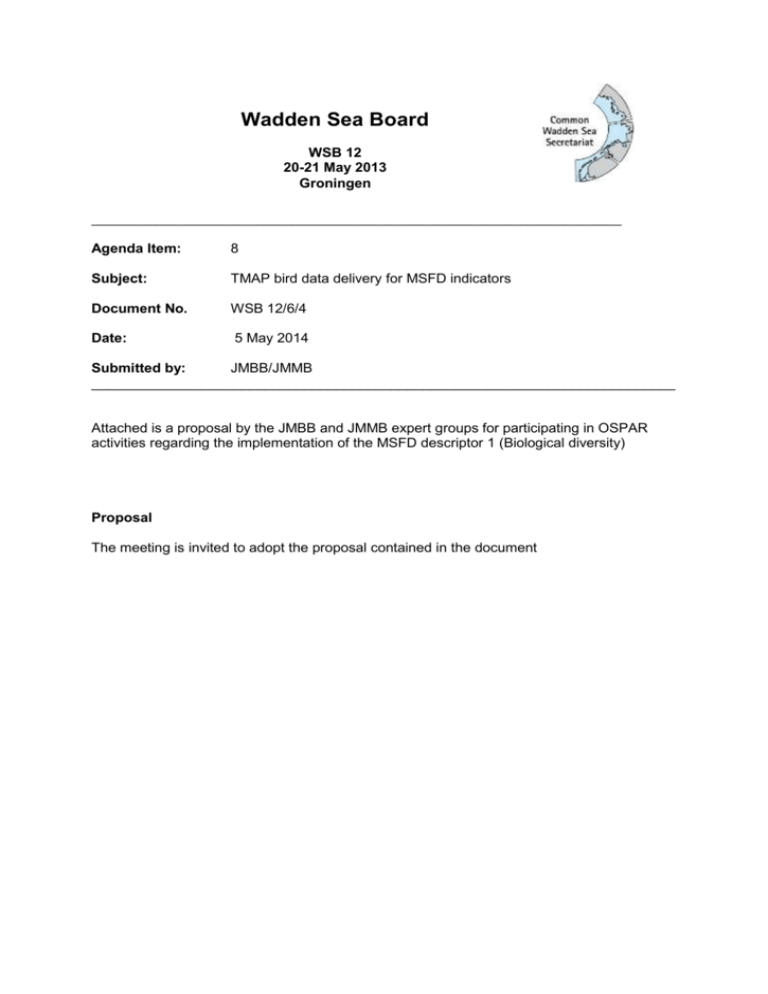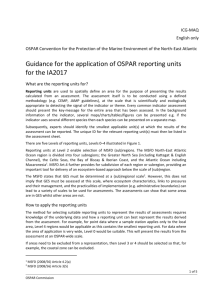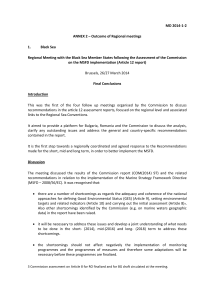TMAP bird data delivery for MSFD indicators
advertisement

Wadden Sea Board WSB 12 20-21 May 2013 Groningen __________________________________________________________________________ Agenda Item: 8 Subject: TMAP bird data delivery for MSFD indicators Document No. WSB 12/6/4 Date: 5 May 2014 Submitted by: JMBB/JMMB __________________________________________________________________________ Attached is a proposal by the JMBB and JMMB expert groups for participating in OSPAR activities regarding the implementation of the MSFD descriptor 1 (Biological diversity) Proposal The meeting is invited to adopt the proposal contained in the document WSB 12/6/4 TMAP bird data delivery for MSFD indicators 2 TMAP bird data delivery for MSFD indicators Objective JMBB/JMMB to deliver TMAP bird data and participate in development of MSFD indicators for birds. Background The breeding and non-breeding bird populations of the Wadden Sea are of fundamental importance for the biological diversity within the Greater North Sea region. Since Wadden Sea and North Sea share many ecological processes, factors operating in the North Sea also influence the environmental status of the Wadden Sea, and vice versa. Many fish-eating birds for instance, depend on developments of fish stocks (e.g. Herring) in the Greater North Sea region. This is also indicated by the occurrence of large bird colonies on the fringe of Wadden Sea and North Sea, e.g. of gulls and terns. The area supports one of the largest breeding populations of the Lesser Black-backed Gull, which uses the North Sea as foraging habitat. Monitoring of these populations, with associated indicators and targets, is required to assess biodiversity and whether the quality and occurrence of habitats and the distribution and abundance of species are in line with prevailing physiographic, geographic and climate conditions (Descriptor 1 of the Marine Strategy Framework Directive (MSFD). Currently, under the umbrella of MSFD, several indicators are developed to assess and monitor the ecological status of the Greater North Sea. Because of the interactions between Wadden Sea and North Sea, as mentioned above, the TMAP monitoring programmes for birds should be an integral part of the MSFD process. This proposal describes how TMAP data should be integrated in the MSFD indicators. It does not request new monitoring schemes, but aims to embed the existing bird monitoring in the MSFD framework, in order to be able to fulfill the requirements set by the MSFD. The joint ICES/OSPAR expert group on seabirds is preparing bird indicators for biological diversity (MSFD Descriptor 1) which aim to guide progress towards achieving good environmental status in the marine environment (art. 10 MSFD). Project plans for the development of two MSFD biodiversity indicators (Annex I) which are relevant for the TMAP bird monitoring are in development: Indicator B1: species specific abundance and trends Indicator B3: breeding success/failure The OSPAR bird indicators are extremely relevant for the Wadden Sea as a sub-region of the OSPAR Greater North Sea region and will also support the existing monitoring regarding the conservation objectives set in the Wadden Sea Plan and those requested by EU Directives. The inclusion of the TMAP parameters in the indicators will require some adaption of the indicators themselves and possibly some refining or adaption of the TMAP parameters. The provision of data of selected bird species is scheduled according to the project plans mentioned above by mid July 2014. WSB 12/6/4 TMAP bird data delivery for MSFD indicators 3 Status The joint JMBB/JMMB meetings 13/2 and 14/1 in November 2013 and March 2014 agreed to deliver trilateral bird data adapted to the needs of the indicators B1/B3 and to support the development of the indicators. However, inclusion of TMAP parameters in the MSFD indicators will require a single effort at the start, e.g. the selection of TMAP bird species, the preparation of count data and input of JMBB/JMMB to the development of the indicators. These will need resources, which cannot fully covered by the secretariat. JMBB/JMMB also recognized that it has no official trilateral mandate to participate in the development of the indicators and to deliver the appropriate TMAP data. The group also remarked that in the Netherlands the Wadden Sea is not considered relevant to the MSFD, contrary to Germany and Denmark. Proposal That the Wadden Sea Board awards JMBB/JMMB the mandate to participate in development of indicators B1/B3 of the MSFD, to support the efforts of JMBB/JMMB in data delivery and indicator development and to give advice on how to handle the fact that in the Dutch Wadden Sea is not subject to the MSFD. WSB 12/6/4 TMAP bird data delivery for MSFD indicators 4 Annex 1 Indicator B1: Species-specific trends in relative abundance of non-breeding and breeding marine birds B1 is based on the OSPAR EcoQO on Seabird population trends as an index of seabird community health, which was adopted by OSPAR’s Biodiversity Committee (BDC) in 2012. The EcoQO has so far been applied only to trends in breeding numbers of colonial-breeding seabird species. In the context of MSFD, abundance indicators could be constructed from time-series data of other groups of marine birds and from data collected at sea. The aims for B1 are to make the common indicator B1 operational in as many sub-regions as possible. The main aims: A. Address generic issues on baselines, assessment scales, targets and reporting, which were identified by the ICES/OSPAR Bird Group (COBAM) on marine birds in the technical specification indicator B-1[1] and from ICES advice to OSPAR on the implementation of the EcoQO on seabird population trends[2]. B. Put in place mechanisms within each sub-region for the central collation and analysis. This will enable Common Indicator B1 to be operational in each sub-region, so that in to the future, there is an efficient process for periodically, constructing contributory indicators and updating them and assessing them against targets. C. Expand the existing indicators for the EcoQO on seabird population trends in the Celtic seas and Greater North Sea to include trends in abundance from as many of the following groups as possible: i. coastal-breeding waterbirds; ii. non-breeding waterbirds; iii. seabirds at sea; iv. non-breeding shorebirds. D. Construct new sub-regional indicators of marine bird abundance for the Bay of Biscay & Iberian Coast and for Macaronesia. Indicator B3: Breeding success/failure of marine birds The first step of this project is to address the following issues around target-setting and species composition of the indicator, which the COBAM bird subgroup have identified as needing to be resolved before further development can take place: i. Is breeding failure universally defined as 0.1 chicks per pair, or by some other threshold – perhaps bespoke to particular species or breeding areas. ii. Are the methods recommended by Cook et al (2012) for defining target thresholds for percentage of colonies failing, applicable across species and breeding areas. iii. Are the targets for this indicator aimed at representing GES or simply means of flagging-up areas of concern that may require for further action (e.g. management measures or further research). iv. Should the indicator include just sensitive species or all species? Hatching and fledging success is monitored for a selection of species breeding on soft coasts and islands e.g. in the Wadden Sea region. Monitoring is carried out on survey plots in colonies and for non-colony breeding shorebirds. Further work is needed to develop this indicator at the sub-regional scale. [1]https://ospar.basecamphq.com/projects/9297130/file/154377155/indicator%20techspec_25_v4.doc [2]https://ospar.basecamphq.com/projects/9297130/file/154379248/0405_ICESadvice_Seabirds.pdf






